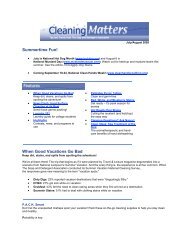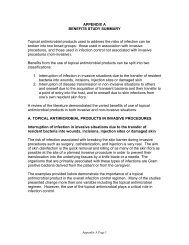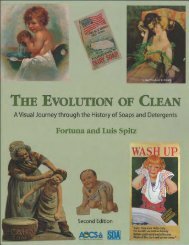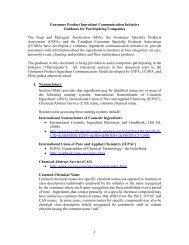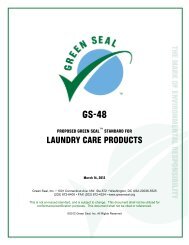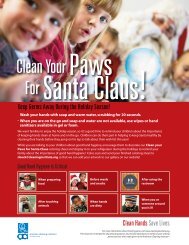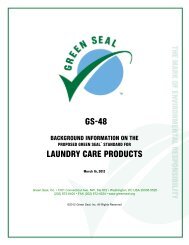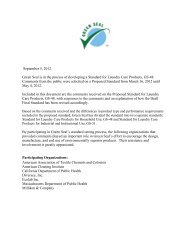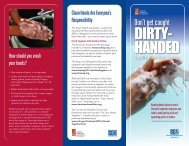subchapter c -- federal hazardous substances act regulations
subchapter c -- federal hazardous substances act regulations
subchapter c -- federal hazardous substances act regulations
Create successful ePaper yourself
Turn your PDF publications into a flip-book with our unique Google optimized e-Paper software.
16 CFR Ch. II (1–1–05 Edition) – proposed modification – 6/25/06<br />
longer appropriate. This is because the use of<br />
salt to induce vomiting can cause severe<br />
hypernatremia (salt poisoning) with potentially<br />
toxic effects, particularly in children 5 years<br />
old or younger, the age group most often<br />
involved in accidental poisonings. In view of<br />
the availability of safer and more effective<br />
emetics such as ipecac syrup, the Commission<br />
no longer recommends a direction to perform<br />
saline emesis as a first aid direction for<br />
inducing vomiting.<br />
(c) The Commission believes that, for<br />
products for which directions for saline emesis<br />
have been given in the past, ipecac syrup,<br />
U.S.P., is the most appropriate emetic, unless a<br />
particular contraindication exists in connection<br />
with any particular <strong>hazardous</strong> substance.<br />
(d) The Commission wishes to emphasize<br />
that this policy does not require that any<br />
specific first aid instruction or wording be<br />
used. Where appropriate, the label may include<br />
directions (1) that the victim immediately<br />
cont<strong>act</strong> a doctor or poison control center<br />
and/or (2) that vomiting be induced using<br />
methods other than salt. It is, of course, the<br />
manuf<strong>act</strong>urer’s responsibility to insure that the<br />
label provides enough information in addition<br />
to first aid instructions to fulfill all other<br />
labeling required by statute or regulation.<br />
§ 1500.135 Summary of guidelines for<br />
determining chronic toxicity.<br />
A substance may be toxic due to a risk of a<br />
chronic hazard. (A regulatory definition of<br />
”toxic” that pertains to chronic toxicity may be<br />
found at 16 CFR 1500.3(c)(2).) The following<br />
discussions are intended to help clarify the<br />
complex issues involved in assessing risk from<br />
<strong>substances</strong> that may potentially cause chronic<br />
hazards and, where possible, to describe<br />
conditions under which <strong>substances</strong> should be<br />
considered toxic due to a risk of the specified<br />
chronic hazards. The guidelines are not<br />
intended to be a static classification system,<br />
but should be considered along with available<br />
data and with expert judgment. They are not<br />
mandatory. Rather, the guidelines are intended<br />
as an aid to manuf<strong>act</strong>urers in determining<br />
whether a product subject to the FHSA<br />
presents a chronic hazard. All default<br />
assumptions contained in the guidelines on<br />
hazard and risk determination are subject to<br />
replacement when alternatives which are<br />
supported by appropriate data become<br />
-- 88 --<br />
available. The following are brief summaries<br />
of more extensive discussions contained in the<br />
guidelines. Thus, the guidelines should be<br />
consulted in conjunction with these<br />
summaries. Copies of the guidelines may be<br />
obtained from the Office of Compliance and<br />
Enforcement, Consumer Product Safety<br />
Commission, Washington, DC 20207. (In<br />
addition to the chronic hazards discussed<br />
below, issues relating to the chronic hazard of<br />
sensitization are discussed in 16 CFR<br />
1500.3(c)(5).)<br />
(a) Carcinogenicity. Substances are toxic<br />
by reason of their potential carcinogenicity in<br />
humans when they are known or probable<br />
human carcinogenic <strong>substances</strong> as defined<br />
below. Substances that are possible human<br />
carcinogenic <strong>substances</strong> or for which there is<br />
no evidence of carcinogenic effect under the<br />
following categories lack sufficient evidence<br />
to be considered toxic by virtue of their<br />
potential carcinogenicity.<br />
(1) Known Human carcinogenic<br />
Substances (“sufficient evidence” in humans).<br />
Substances are toxic by reason of their<br />
carcinogenicity when they meet the ”sufficient<br />
evidence” criteria of carcinogenicity from<br />
studies in humans, which require that a causal<br />
relationship between exposure to an agent and<br />
cancer be established. This category is similar<br />
to the Environmental Protection Agency's<br />
(EPA) Group A, the International Agency for<br />
Research on Cancer's (IARC) Group 1, or the<br />
American National Standards Institute's<br />
(ANSI) Category 1. A causal relationship is<br />
established if one or more epidemiological<br />
investigations that meet the following criteria<br />
show an association between cancer and<br />
exposure to the agent.<br />
(i) No identified bias that can account for<br />
the observed association has been found on<br />
evaluation of the evidence.<br />
(ii) All possible confounding f<strong>act</strong>ors which<br />
could account for the observed association can<br />
be ruled out with reasonable confidence.<br />
(iii) Based on statistical analysis, the<br />
association has been shown unlikely to be due<br />
to chance.<br />
(2) Probable Human Carcinogenic<br />
Substances. Substances are also toxic by<br />
reason of their probable carcinogenicity when<br />
they meet the ”limited evidence” criteria of<br />
carcinogenicity in humans or the ”sufficient<br />
evidence” criteria of carcinogenicity in



